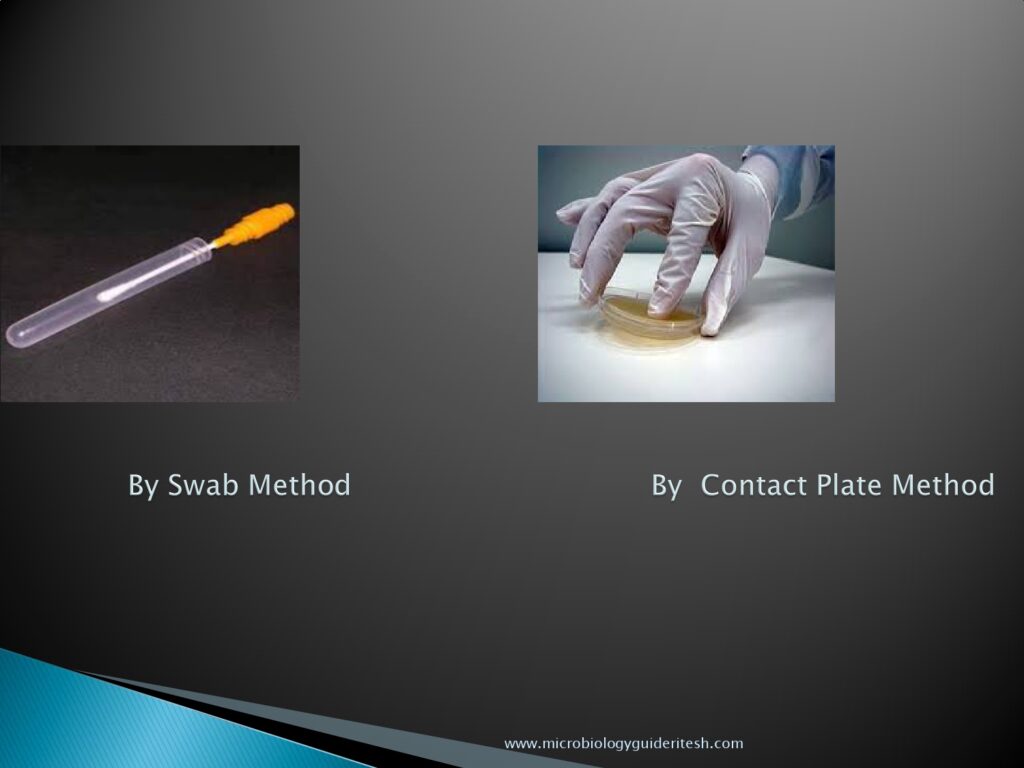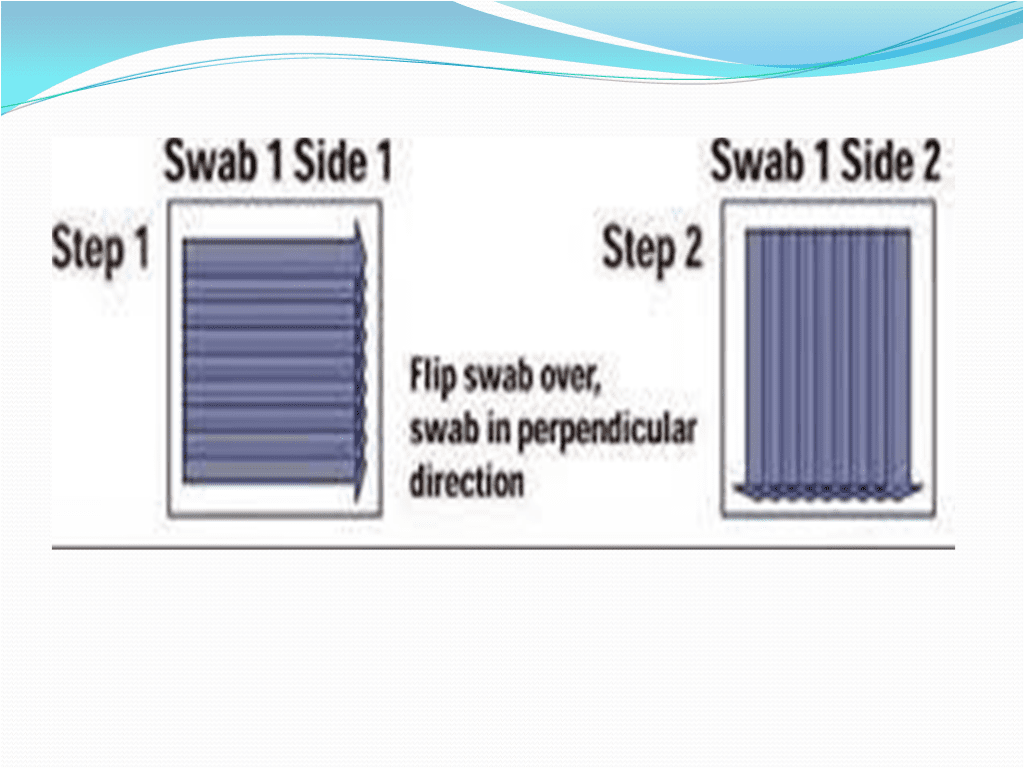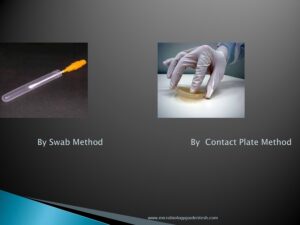Surface Monitoring by Swab Method
Swab sampling is a technique used to collect samples from surfaces or objects for laboratory analysis. It involves using a sterile swab to collect a sample from a specific area or object, which is then sent to a laboratory for testing.

Swab sampling is commonly used in healthcare settings to detect and monitor infectious diseases, such as Methicillin-resistant Staphylococcus aureus (MRSA) and Clostridium difficile (C. diff). It is also used in food safety testing to detect the presence of harmful bacteria, such as Salmonella and E. coli.
To perform a swab sampling, a sterile swab is moistened with a sterile solution and rubbed over the surface or object being tested, applying enough pressure to ensure that the swab collects any microorganisms present. The swab is then placed in a sterile container and sent to the laboratory for analysis.
Swab sampling is a simple and non-invasive technique that can provide valuable information about the presence of microorganisms on surfaces or objects. It is an important tool for infection control and prevention in healthcare settings and for ensuring food safety in the food industry.
Procedure of Swab Sampling:
- Take pre-sterilized readymade cotton swab.
- Add 0 mL sterile normal saline/ 0.1% Peptone water in to swab tube for wetting the cotton bud.
- Bring the swab tubes at the sampling location.
- Aseptically open the swab tube containing with normal saline/ Peptone water solution. Take out the sterile swab partially, press the swab to the internal walls of the tubes gently to remove the excess saline/ peptone water and take it out gently.
- Swab out 5 X 5 cm2 area in the direction specified in figure below. Use sterile stainless steel template to measure the area of sampling whenever applicable.

- Place the swab back in the tube.
- After completion of sampling, label each swab with sample name, date of sampling and initial sign of microbiologist and bring the swab to microbiology department.
Procedure of Analysis of Swab Sample:
- Transfer the swab samples to the micro lab-1 through the dynamic pass box between MLT passage to Incubation room and sample shall be transfer as per the respective SOP of Material Flow in the Microbiology Department.
- Sanitize hand with 0.2µ filtered 70% IPA.
- Arrange the sterile manifold unit and pre-incubated SCDA plates in laminar air flow.
- Make the attachments of manifold unit to the suction pump and waste water reservoir.
- Fix the sterilized filtration cup/ funnel on the manifold unit and place the sterilize 0.45 µm membrane filters on the sterile filtration cup and funnel with the help of sterile forceps taking care that the forceps does not damage the filter and touch anywhere.
- Pre-wet the 0.45 μm membrane filter with approx. 100 mL of 0.1 % peptone water. Open the knob of the manifold unit so that the rinsing fluid filters through the membrane.
- Shake the swab sample well and after completion of filtration, transfer the content of swab sample in the filtration cup and open the knob of manifold unit so that the sample filters through the membrane.
- Transfer 3 X 100 mL of rinsing fluid (0.1 % peptone water) in the filtration cup. Filter the rinsing fluid with the help of vacuum pump.
- Remove the filtration cup and transfer the 0.45 µm membrane filter on the surface of pre incubated SCDA media plates with the help of sterile forceps.
- Prepare one negative control plate by filtering 100 mL of sterile 0.1 % peptone water through the 0.45 µm membrane filters and put the 0.45 µm membrane filters on the surface of pre-incubated SCDA plate and incubate along with test samples.
- Incubate the plates with the membrane in inverted position at 22.5 ± 2.5 °C for 72 hours and 32.5 ± 2.5 °C for 48 hours.
- After Completion of incubation period, withdrawn the plate from respective Incubator and observe the plate and record the result .
Pingback:-



I just like the helpful information you provide in your articles
I’ve read some really great material here, and it’s worth bookmarking for later. I wonder how much work goes into creating a website this good and educational.
Wonderful web site Lots of useful info here Im sending it to a few friends ans additionally sharing in delicious And obviously thanks to your effort
I was recommended this website by my cousin I am not sure whether this post is written by him as nobody else know such detailed about my trouble You are amazing Thanks
I have been browsing online more than three hours today yet I never found any interesting article like yours It is pretty worth enough for me In my view if all website owners and bloggers made good content as you did the internet will be a lot more useful than ever before
helloI really like your writing so a lot share we keep up a correspondence extra approximately your post on AOL I need an expert in this house to unravel my problem May be that is you Taking a look ahead to see you
Hi i think that i saw you visited my web site thus i came to Return the favore I am attempting to find things to improve my web siteI suppose its ok to use some of your ideas
My brother recommended I might like this web site He was totally right This post actually made my day You cannt imagine just how much time I had spent for this information Thanks
interesting post
Somebody essentially lend a hand to make significantly articles Id state That is the very first time I frequented your website page and up to now I surprised with the research you made to make this actual submit amazing Wonderful task
I got good info from your blog
Myself I think it’s poppycock, my opinion of myself has no bearing on anything except destined for people trapped in a sisterhood that obsesses nearby relative rank.
But you can unendingly [url=https://www.moviesjoy.today]watch experimental movies[/url] instead of uninhabited to the Internet.